Hibernation is a useful option available in Windows 11. Although you can metaphorically shut down your system without closing any open windows or applications. You can then resume work by waking the system from hibernation. Interestingly, Windows in hibernation still runs background services and has some updates to programs and applications.

Whether you want to take a break or want to avoid wasting time booting up your computer, Hibernation is a time saver. We’ll show you how to enable and use hibernation on Windows 11. But before we get there, let’s first understand what hibernation on Windows is and how it works.
What is hibernation on Windows 11?
Hibernation is a power-saving state in which Windows takes a snapshot of your system and saves that content to your hard drive before shutting down the system. When you turn your computer back on, it will read the memory status from the storage and restore all your open programs and data exactly as they were when you left them.

Unlike sleep mode, hibernation uses less power. So, if you don’t plan to use your PC for a long time, you should hibernate it instead of putting it to sleep. That way, you can keep your laptop battery from draining. When you’re ready to resume work, you can press the power button to turn on your computer.
Check out how you can enable Hibernation on your Windows computer.
How to Enable Hibernation on Windows 11
To use Windows 11 hibernation mode, you must first enable it on your computer. Thankfully, it’s pretty easy to enable the mode.
Step 1: Right-click on the Start icon and select Terminal (Admin) from the list.

Step 2: Type the following command in the Command Prompt window and press Enter:
powercfg/available sleep states

Step 3: Check if hibernation is enabled on your PC. If not, run the following command to enable it.
powercfg.exe/hibernate on

That will enable Hibernation on your Windows 11 PC.
How to add Hibernate option to Power Menu
Even after enabling hibernation on your PC, the Hibernate option does not appear on Windows 11’s power menu by default. You can use the steps below to add the Hibernation option to the power menu.
Step 1: Click the search icon on the Taskbar, type dashboardthen press Enter.

Step 2: Use the drop-down menu in the upper right corner to change the view type to Small or Large Icons and select Power Options.

Step 3: Click on ‘Choose what the power buttons do’ from the left column.

Step 4: Click ‘Change settings that are currently unavailable.’

Step 5: Check the Hibernate option and click Save Changes.

After completing the above steps, you will see the Hibernate option in the Windows 11 power menu.

How to Customize and Use Hibernation on Windows 11
Once you’ve added the Hibernate option to the power menu, you can use it to hibernate your PC at any time. However, if you plan to use hibernation frequently, you can configure Windows to go into hibernation when the power button is pressed or the laptop lid is closed. Here’s how to do it.
Step 1: Press the Windows + R key combination to open the Run dialog box. Type control in the Open field and press Enter.

Step 2: Go to Power Options.

Step 3: Click ‘Choose what the power buttons do.’

Step 4: Use the drop-down menu next to ‘When I press the power button’ to select the Hibernate option.

Step 5: For Windows laptops, use the drop-down menu next to ‘When I close the lid’ to select the Hibernation option.

Step 6: Finally, click Save Changes.

And you are ready. Windows goes into hibernation when you press the power button or close the lid.
Conveniently, you can also configure your PC to automatically hibernate after a period of inactivity. This is the way.
Step 1: Press Windows key + S to open the search menu. Type electrical diagram editing in the box and select the first result that appears.

Step 2: Click ‘Change advanced power settings.’

Step 3: In the Power Options window, double-click Sleep to expand it.

Step 4: Expand Hibernate after and use the drop-down menus next to On battery and Plugged in to specify the number of minutes of inactivity, after which your PC will go into hibernation. Then press Apply followed by OK.

Windows 11 hibernation
Hibernation is a useful option to start your computer without consuming a lot of resources and without losing any of your work. You’ll also get back to work pretty quickly because booting from hibernation takes less time than shutting down completely.
Categories: How to
Source: thpttranhungdao.edu.vn/en/

